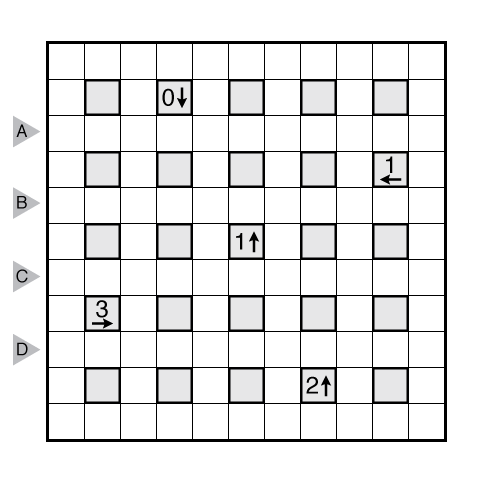Doctor’s Note: Why Our Yajilin Look Different
We will soon begin to regularly post Yajilin puzzles here. Yajilin is a style that is quite different from the other loop styles we have at the moment. Most of those have to do with how a loop travels in small regions. Masyu puzzles, for example, contain clues that require a loop to go straight or turn in specific cells; most of the logic focuses around how to make the loop obey these path instructions. Yajilin is focused more on where a loop travels, which is almost everywhere in the grid. As a variation on other “visit all cells” loop puzzles, the logic in Yajilin revolves around how to get in and out of every part of the grid with only a few cells untouched.
While the style may be familiar, our Yajilin will not look exactly like the Yajilin puzzles you are used to seeing elsewhere. We strongly believe that a wider range of puzzles, and more interesting puzzles, are possible if constructors are allowed to mark some cells as “unused” — neither white nor black. In the standard format, all of these spots would then need arrow clues resulting in excessive and often redundant clues that can subtract from the potential aesthetics or logic of a puzzle. It would simply be impossible to make a standard Yajilin with the curious but pedagogical properties of this example puzzle below.
Increasing the flexibility for the puzzle designer to include known spots that the loop cannot enter seems to meaningfully increase the range of possible Yajilin puzzles. So this is what Grandmaster Puzzles will do with our Yajilin puzzles (although sometimes they may still look “classic”). We hope the change only adds to your enjoyment of this puzzle style.

or solve online (using our beta test of Penpa-Edit tools)
Theme: Easy as (0,) 1, 2, 3?
Rules: Standard Yajilin rules.
Answer String: Enter the length in cells of the horizontal loop segments from left to right in the marked rows, starting at the top. If the loop only has vertical segments in the marked row, enter 0. Separate each row’s entry with a comma.
Time Standards (highlight to view): Grandmaster = 1:15, Master = 2:30, Expert = 5:00
Solution: PDF

Logically, I like this presentation of Yajilin better. Being forced to put arrows in the blocks always struck me as clumsy. If you are putting in a block just to have a block, the arrow will either be useless noise (inelegant), or unintentionally useful, which could short-circuit the logic of the puzzle.
I would also say that this doesn’t strike me as a profound change from the solving point of view, although it does allow for some interesting designs. I regard it as much the same as letting many of the sums in a Kakuro be unclued, having unclued rows/columns in something like a battleships puzzle, etc.
For me, the most interesting thing in this puzzle (and I assume much of the point) was the logic “behind the arrows”.
So I managed to see exactly the logic that was required to solve this one pretty much right away, but that didn’t stop me from breaking it not once but TWICE. The first time I mentally confused “number of black squares” with “number of pathways” instead of its complement (I have no idea why). The second time, I sped right through, got to the end, and noticed I had two loops. Don’t solve while tired! Don’t solve while tired!
I totally agree with this. Based on its original format, yajilin is extremely wasteful with the clues it uses – rendering a good, challenging puzzle almost generic. This format solves much cleaner and it more tailored for puzzling.
03:20.
My point has been addressed by Jack Bross, heh. I’ll additionally state that this is similar to using question marks in Tapa too, where the existence of a given means something even if the given is unknown.
Actually, I now think that this is just less usual than question marks in Tapa so that it seems like a large difference; technically it’s the same as if you put a question mark in each of the empty cells, indicating an unknown number of black squares in an unknown direction (basically a useless given except for the fact that it’s a given). When you think a Yajilin with question marks, it’s much smaller difference than the original Yajilin, just like a Tapa with question marks.
I never really considered that all arrows need to be given to be a rule. But then again I never grew up on Nikoli, so a lot of “construction rules” never really got engrained in me. I always found that Yajilin suffers more from clue squares not being chosen in advance and just being added where they seemed easiest for the design. A lot of Nikoli genres seemed to have this symmetry requirement added for construction, but somehow Yajilin avoided that and I don’t see why it has to.
I write most Yajilins to have all clues given but even if they are not needed for uniqueness, they never ruin the intended solve. I only leave them out if they would severely impair the intended solve. I don’t think a clue that just gets resolved during the natural solve but doesn’t ruin the solve is necessarily ugly and should be removed. It’s okay to have a red herring in your puzzle once in a while, as long as it doesn’t provide shortcuts to your intended path.
For the same reason that symmetry is optional in Nurikabe and Masyu, I suppose. Forcing symmetry for symmetry’s sake closes off the puzzle space somewhat. In Fillomino or Slitherlink, you can always add a given absolutely anywhere, but in Yajilin, it’s not like that.